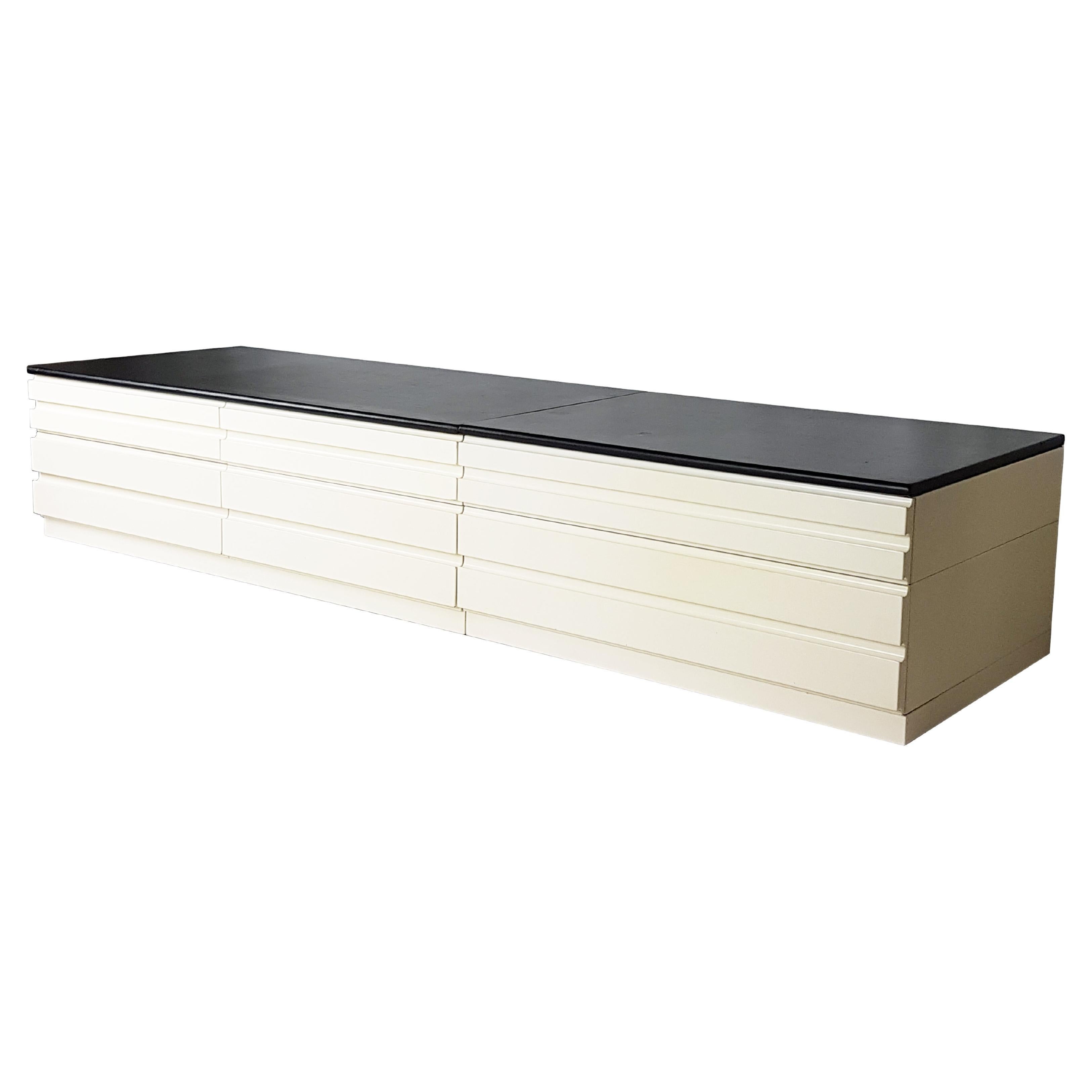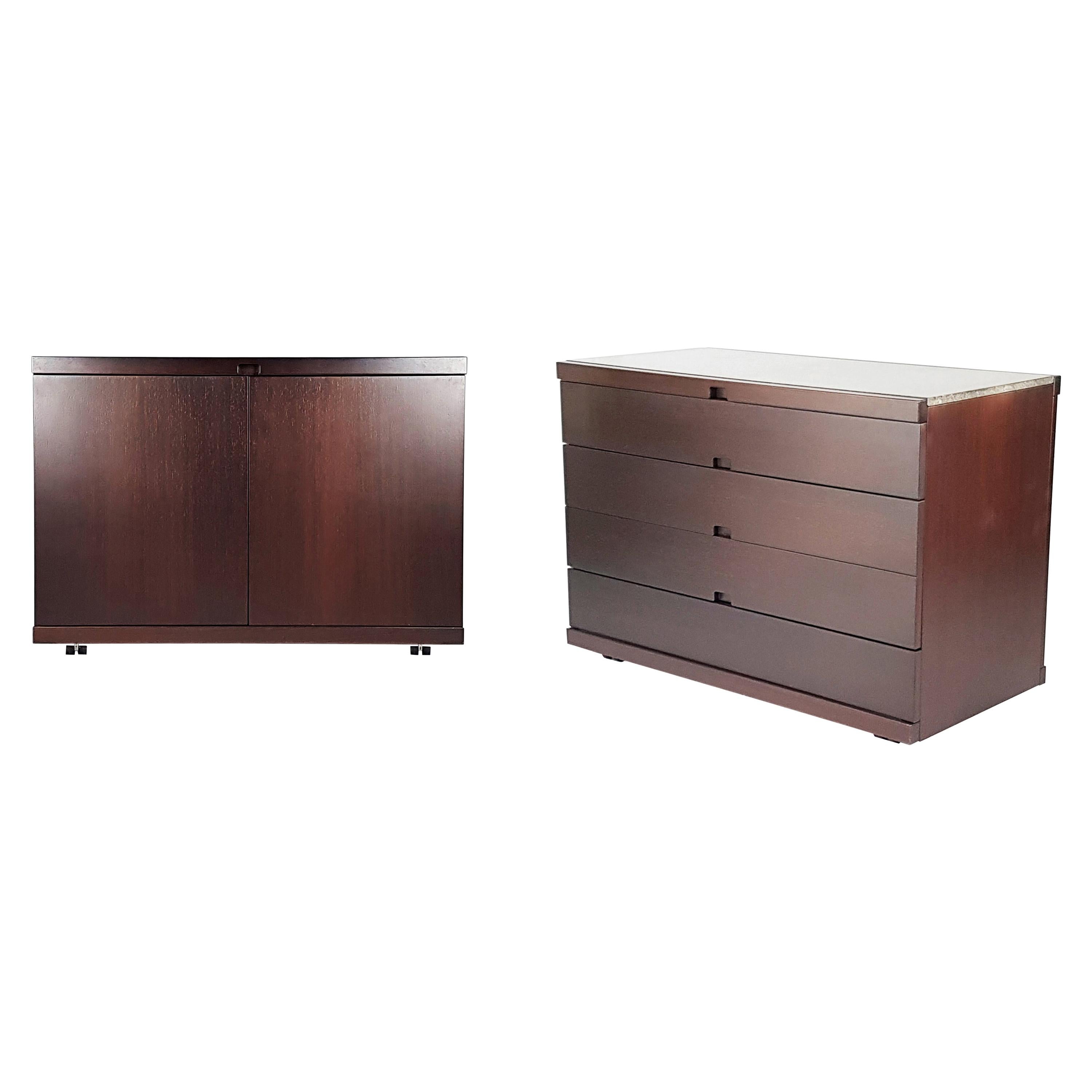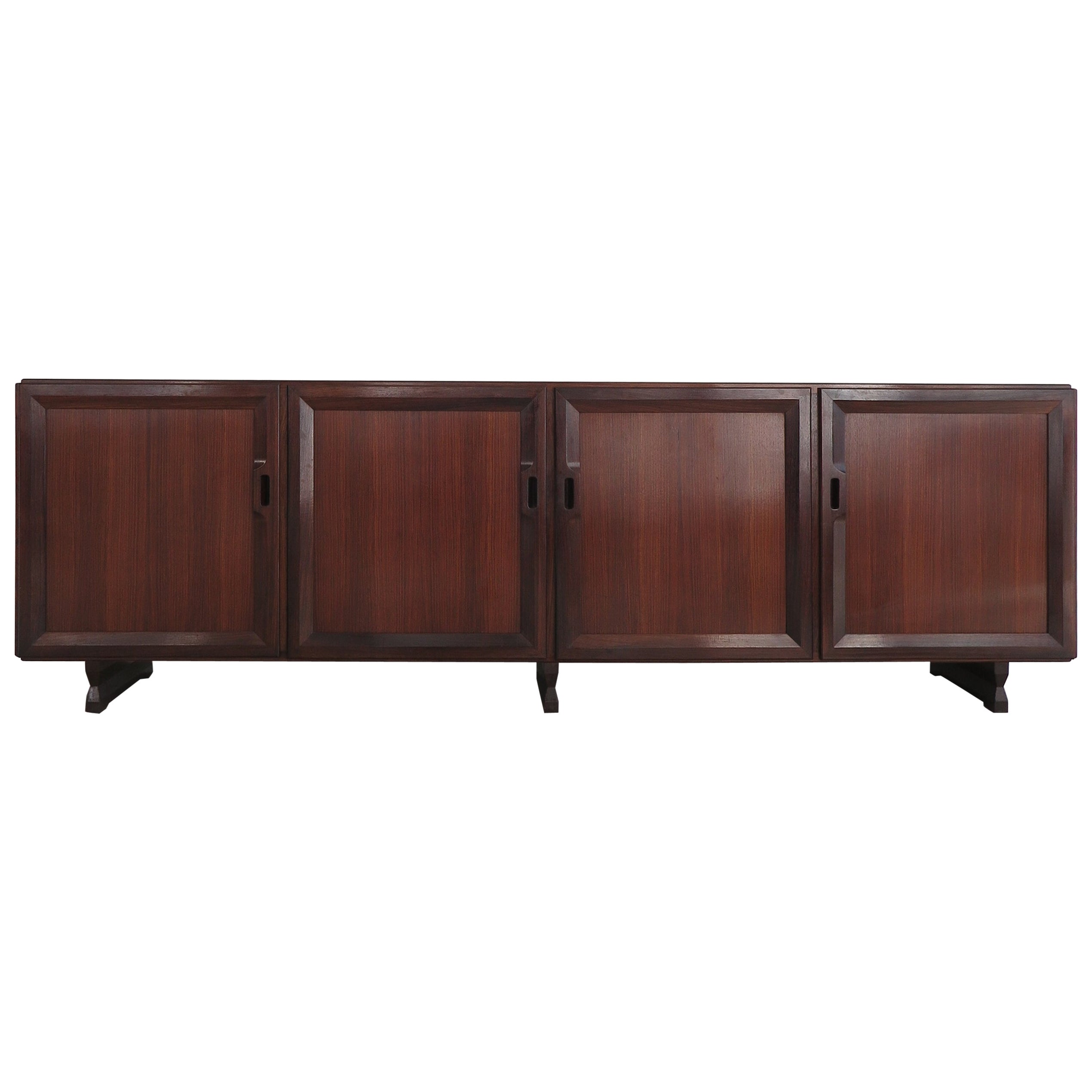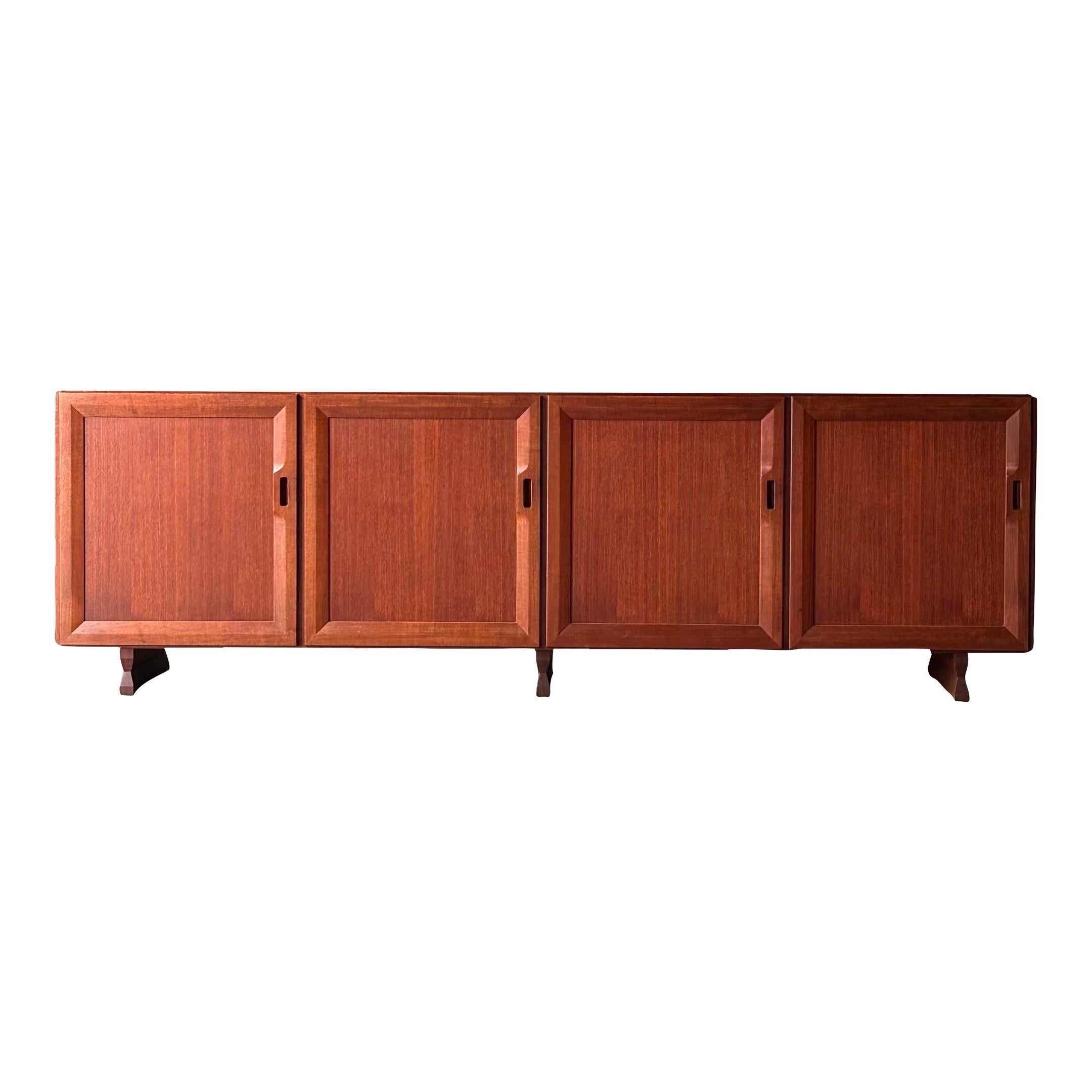Vico Magistretti Samarcanda Sideboard in Black Wood and Skai by Poggi 1970s
About the Item
- Creator:Vico Magistretti (Designer),Poggi (Manufacturer)
- Dimensions:Height: 29.14 in (74 cm)Width: 86.62 in (220 cm)Depth: 21.26 in (54 cm)
- Style:Post-Modern (Of the Period)
- Materials and Techniques:
- Place of Origin:
- Period:
- Date of Manufacture:1970s
- Condition:Wear consistent with age and use.
- Seller Location:Montecatini Terme, IT
- Reference Number:1stDibs: LU5304231148972
Vico Magistretti
As one of the founding fathers of modern Italian design, prolific architect and industrial designer Ludovico Magistretti (known by his nickname Vico) was guided by his philosophy, “There is no excuse for bad design.” His architectural projects are widely revered, and an ingenious meld of form and function can be found in his stylish and deceptively simple table lamps, sofas, armchairs and other mid-century furnishings.
Born in Milan, Magistretti followed in the footsteps of his father and grandfather (both architects) to study architecture at the Polytechnic University of Milan. At the outbreak of World War II, he fled to Switzerland, and it was there he met his role model and mentor, renowned humanist architect Ernesto Nathan Rogers. Magistretti was inspired by Rogers’s vision to revive postwar Italy, and they collaborated on several reconstruction projects. Among Magistretti’s first architectural designs is a “poetic” round church, which he created for the QT8, an experimental Milanese neighborhood.
When Magistretti returned to Milan in 1945, he worked at his father’s architectural firm. It wasn’t until the early 1950s that he expanded his talents into design while working with furniture artisans.
In the 1960s, Magistretti began his 30-year working relationship with famed entrepreneur Cesare Cassina of the Cassina furniture manufacturing company. In their design approach, the two men shared a vision of the relationship between modernity and tradition and enjoyed a close bond (Magistretti designed Cassina’s luxurious villa in 1965). However, their friendship was not without contention.
Legend has it that upon seeing the prototype for Magistretti’s Maralunga sofa, Cassina hated it so much that he punched it, breaking the back of the sofa, which crumpled into itself.
“Right, great, it looks perfect to me like that,” an unfazed Magistretti allegedly responded, and the Maralunga’s slumped, adjustable-height backrest was born. Incidentally, the Maralunga sofa won Italy’s Compasso d’Oro award as did his Eclisse lamp for Artemide and his Atollo lamp for Oluce.
Magistretti died in 2006, but his designs live on in galleries, museums and private residences and offices around the world.
Find a range of vintage Vico Magistretti furniture and lighting on 1stDibs.
- ShippingRetrieving quote...Ships From: Florence, Italy
- Return PolicyA return for this item may be initiated within 7 days of delivery.
- Vico Magistretti Tema Square Table in Black Lacquered Wood by B&B 1970sBy B&B Italia, Vico MagistrettiLocated in Montecatini Terme, ITSquare table model Tema with structure in black lacquered wood and diagonal inserts in natural spruce on top. Designed by Vico Magistretti and produced by B&B, 1973, Italy. Lict...Category
Vintage 1970s Italian Mid-Century Modern Dining Room Tables
MaterialsWood, Spruce
- Giotto Stoppino Sheraton Sideboard in Black Lacquered Wood by Acerbis 1970sBy Giotto Stoppino, AcerbisLocated in Montecatini Terme, ITSheraton sideboard in black lacquered ash wood, with a glossy finish, laminated and glass shelves, designed by Giotto Stoppino and produced by Acerbis in 1977 ca. The sideboard pres...Category
Vintage 1970s Italian Mid-Century Modern Sideboards
MaterialsLaminate, Wood, Ash
- Giovanni Michelucci Torbecchia Sideboard in Walnut Wood by Poltronova 1964By Poltronova, Giovanni MichelucciLocated in Montecatini Terme, ITTorbecchia sideboard is entirely realized in solid veneered walnut wood, with two frontal hinging doors (inner shelves), two drawers, and a storage unit under the openable top part. ...Category
Vintage 1960s Italian Mid-Century Modern Sideboards
MaterialsWalnut, Wood
- Franco Albini PL19 or Tre Pezzi Armchair in Red Fabric by Poggi 1970sBy Franco Albini and Franca Helg, PoggiLocated in Montecatini Terme, ITPL19 or Tre Pezzi armchair with frame in black lacquered tubular steel, seat and back in padded red fabric. Designed by Franco Albini and Franca Helg in 1959 for the Nuove terme Lui...Category
Vintage 1970s Italian Mid-Century Modern Armchairs
MaterialsSteel
- Emilio Lancia Large Sideboard in Walnut Wood Italian Manufacture 1930sBy Emilio LanciaLocated in Montecatini Terme, ITA mid-century sideboard with structure in walnut veneer with brass details, the sideboard presents three doors and six inner shelves. Designed by Emilio Lancia, Italian manufacture ...Category
Vintage 1930s Italian Mid-Century Modern Sideboards
MaterialsBrass
- Pier Luigi Colli Large Sideboard in Wood with Drawers Italian Manufacturer 1930sBy Pier Luigi ColliLocated in Montecatini Terme, ITLarge sideboard is entirely realized in oak wood, with four drawers on each side (for a total of eight drawers) and a central storage unit. Designed by Pier Luigi Colli Italian Manufacture from 1938 ca. To reconstruct the story of Pier Luigi Colli, we must take a leap back to the 19th century in Turin, a multifaceted city, in some ways controversial due to its austere and sometimes introverted character, but at the core of a creative drive: and if it is primarily known for its automobile industry, there was a time when Turin was at the height of fame also in the field of furniture and embroidery, thanks to the presence of two entrepreneurial realities. On the one hand there was the MIRAM (Italian Hand-Made Embroidery Manufacture) founded by Pietro Colli in 1850, specializing in gobelin fabrics and bandera embroideries. His daughter Teresa traveled between Italy and Paris to discover the latest trends in fabrics and embroidery, while her younger brother, Pier Luigi Colli (1895-1968), the star of this story, joined the company in 1921. Distinguishing himself for his enterprising personality and willing to continue his father's profession, Pier Luigi was known to his contemporaries as "the artist interior designer", and had no doubts about his future: he moved temporarily to Paris, where he attended L'Ecole des Beaux Arts Décoratives. The other great Turin manufacturer to be mentioned is Martinotti, founded in 1931 by Giuseppe Martinotti and supplier of fine furnishings for the Savoy court, pieces which were characterized by a typically 19th century eclectic style, generally made of exotic woods featuring ivory and tortoiseshell inlays: at that time, Martinotti represented the top of internationality, having even participated in the 1875 Philadelphia exhibition! The two brands' fate merged in 1902, a decisive year for Turin which, hosting the International Exhibition of Modern Decorative Art, became the cradle of the spread of the Liberty style in Italy. In the exhibition, Martinotti exhibited an elegant interior, in which all the textile parts, from the curtains to the seat upholstery, was made by Colli. It was in 1926 that Colli (MIRAM) finally acquired Martinotti, founding a laboratory where, from the savoir faire of the two companies, complete pieces of furniture were created and tailor-made for the customer, from the structure to its upholstery. Meanwhile, Pier Luigi Colli was living in Paris, the ideal place to be in 1925, when the International Exhibition of Modern Decorative and Industrial Arts brought him closer to the work of one of his putative fathers, the great French cabinet maker Jacques-Émile Ruhlmann (Paris, 1879 - 1933). Thanks to Paris, Pier Luigi intertwined contacts with the international beau monde, he started to import Lalique glass from France, while the Colli's clientele expanded and special commissions arrived, such as the creation of the Royal Train of the Savoy family made with Fiat, or the lecture hall in the University of Turin. The success of a brand is also measured by its openness to establishing collaborations with the great designers of its time, in the case of Colli resulting in important creative partnerships: from Gio Ponti, who relied on the brand for his Richard Ginori project in Rome, up to Carlo Mollino, who created with Colli the handrails of the RAI (national TV) auditorium and the windows of the Teatro Regio in Turin; also in Turin, the Morbelli architects collaborated with Colli for the furnishings of the RAI skyscraper, and the architects Gabetti Isola for the interiors of the Stock Exchange in Turin. In the 40s and 50s, having opened a branch in Rome, Colli was at the peak of productivity. The embroidery and textile section continued to be one of its strengths, keeping alive the relations with France and its great masters: among the inspirations were the geometric shapes of the fabrics of Ruhlmann's interiors, or the tactile carpets made by designer Mariod Dorn. And so, another Colli trademark become the "textured carpet...Category
Vintage 1930s Italian Mid-Century Modern Sideboards
MaterialsWood, Oak
- White Wood and Black Skai Samarcanda Chest of Drawers by Magistretti for PoggiBy Vico Magistretti, PoggiLocated in Varese, LombardiaWooden structure painted in white polyurethane color. Black skai cover on the top (light defects at some corner). Large chest of drawers: cm 34,5h x 107w x 53,5d Small chest of dra...Category
Vintage 1970s Italian Space Age Commodes and Chests of Drawers
MaterialsFaux Leather, Wood
- Pair of Wooden and Marble Storage Unit by V. Magistretti for Poggi, Italy, 1970sBy Vico Magistretti, PoggiLocated in Varese, LombardiaThis set is composed by one chest of drawers and one cabinet. They were designed by Vico Magistretti and produced by Poggi, circa 1970. They can be used as a separate units or as a u...Category
Vintage 1970s Italian Modern Cupboards
MaterialsMarble, Metal
- Franco Albini Italian Midcentury Dark Wood Sideboard for Poggi, 1950sBy Franco Albini, PoggiLocated in Reggio Emilia, ITItalian Mid-Century Modern design credenza sideboard designed by Franco Albini and produced by Poggi Pavia from 1958, four doors with sliding shelves and a pull-out shelf / tray, sol...Category
Antique 1850s Italian Mid-Century Modern Sideboards
MaterialsWood
- Italian Franco Albini for Poggi SideboardBy Franco Albini, PoggiLocated in Hudson, NYAn Italian model MB 51 sideboard designed by Franco Albini for Poggi. Made of solid teak with a minimalist design and sharp lines.Category
Mid-20th Century Italian Mid-Century Modern Sideboards
MaterialsTeak
- Large Franco Albini for Poggi 'MB15' Sideboard in TeakBy Franco Albini, PoggiLocated in Waalwijk, NLFranco Albini for Poggi, sideboard model MB 15, teak, Italy, design 1957 Well-designed sizable sideboard by Franco Albini for Poggi in the 1950s in Italy. This design features a sim...Category
Vintage 1950s Italian Mid-Century Modern Sideboards
MaterialsTeak
- Franco Albini Stunning wood MB15 Sideboard for Poggi, Italian Design 1950sBy Franco Albini, PoggiLocated in Milan, ITModern sideboard by Franco Albini for Poggi - 1950s Italy. This design features a simplistic aesthetic with sharp lines. It has four compartments with doors. The sculptural legs giv...Category
Vintage 1950s Italian Sideboards
MaterialsWood, Walnut






